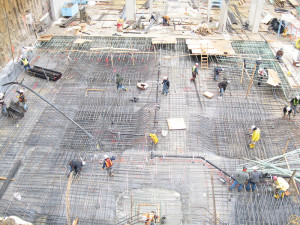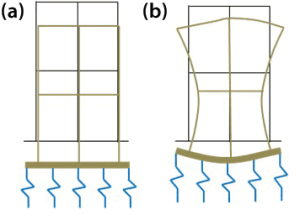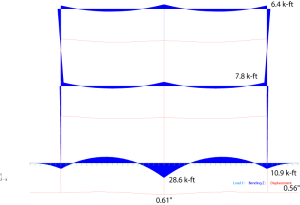The Subgrade Modulus, also known as the Modulus of Subgrade Reaction, is a stiffness parameter typically used in defining the support conditions of footings and mat foundations, such as that shown on Figure 1. The parameter is expressed in units of [Force]/[Length]3. Physically however, it is defined as the (contact) bearing pressure of the foundation against the soil that will produce a unit deflection of the foundation. The use of the parameter implies a linear elastic response, and therefore in design the pressure generated by the subgrade modulus is always limited by the allowable bearing pressure of the soil.
In practice, the parameter is often recommended by the Geotechnical Engineer and used by the Structural Engineer for analysis of the structure. The structural analysis is not only used to gain insight into the settlement of the structure, but also provides consideration of settlement-induced stresses within the structure. In a structural analysis process, the subgrade modulus is typically utilized to obtain a vertical spring constant ([Force] / [Length]) by multiplying the subgrade modulus with the tributary area of the spring support elements.
As a parameter that spans the geotechnical and structural realms, the subgrade modulus has been used and abused in practice, to a point where engineers tend to forget the physical meaning of and implications of the use of the parameter. This article will revisit the concept of the Subgrade Modulus by presenting and discussing common misconceptions of the parameter.
Misconceptions
Statement 1: The Subgrade Modulus is a soil property.
False. The subgrade modulus takes its theoretical origins from the formulation of Winkler-type beams-on-elastic-foundations (Hetenyi 1946). The subgrade modulus is a lumped constant of integration of the differential equation of a beam supported by elastic springs. It is a function of the following:
- Soil elastic properties: Modulus of Elasticity, Es, and Poisson’s Ratio, νs.
- Foundation plan dimensions: Length, L, and Width, B.
- Foundation stiffness: Modulus of Elasticity, Ef, and Moment of Inertia, If.
- Other indirect factors: Compressible soil layer thickness, Hs, and depth of foundation below ground surface, D.
As early as 1955, Terzaghi had suggested a conversion factor that involves the ratio of the size of footings to that of a plate load test to obtain the appropriate subgrade modulus for the footing. This implies that, for a given soil, the subgrade modulus is inversely proportional to the size of the footing.
It can be concluded from the above that an adequate evaluation of the subgrade modulus requires both geotechnical and structural information.
Statement 2: The Subgrade Modulus is constant beneath the foundation.
False. The ratio of the bearing pressure to the settlement within the footprint of the foundation varies according to a number of factors. Some researchers (Dey et al. 2008) have proposed formulations that include confining stress effects on the stiffness of granular soil, which generally decreases from the center of the foundation to the edges. However, in the opinion of the authors, the most dominant factors causing non-uniformity of the subgrade modulus beneath the foundation are the bearing pressure distribution and deformation compatibility mode.
The distribution of the bearing pressure, even for a uniformly loaded finite foundation, is affected by the stiffness of the foundation as it settles, and the settlement profile. Consider the cases illustrated below.
For a very flexible foundation, the uniformly applied load essentially produces a uniform bearing pressure, as shown on Figure 2a. However, by compatibility of deformation at the edges of the foundation, i.e., the settlement profile cannot be discontinuous at the edges, the foundation does not settle uniformly, producing a maximum settlement at the center and minimum at the edges. Taking ratios of bearing pressure to settlement suggests that the maximum subgrade modulus occurs at the edges of the foundation.
On the other hand, a uniformly loaded very stiff foundation will essentially settle uniformly. However, because the edges of the foundation represent an abrupt change in stiffness causing a discontinuity in the slope of the settlement profile, the bearing pressures spike at the edges and decrease as the center of the foundation is approached, as shown on Figure 2b, noting that the bearing pressure at the edges may taper off to the bearing capacity if it is approached. The areas of the bearing pressures of Figures 2a and 2b are equal, but the intensity of the bearing pressure underneath a stiff foundation varies. Taking ratios of bearing pressure to settlement for a very stiff foundation, it is observed that the subgrade modulus also increases towards the edges of the foundation.
The non-uniformity of the settlement profile, even under a uniformly loaded flexible foundation, is primarily caused by the soil deformation mode along the foundation as imposed by continuity of settlement. Under the center of the foundation, the primary deformation mode is vertical compression. However, at the edges of the foundation, the soil is also undergoing shear distortion in addition to compression. This combined deformation mode produces a stiffer net vertical response from the soil, thereby resulting in a smaller settlement. Furthermore, the zone of influence, or stress bulb, of the bearing pressure is shallower at the edges than at the center of the foundation. A constant subgrade modulus used under a uniformly loaded very flexible foundation will result in a uniform settlement, which is clearly erroneous.
To capture the intrinsically multi-dimensional nature of the deformation mode, as opposed to a purely vertical mode using vertical subgrade moduli, some researchers (e.g. Teodoru 2009) have developed a two-parameter formulation of beams-on-elastic-foundations involving the subgrade modulus and another parameter which considers the shear distortion of the soil and an assumption of the curved deformation pattern. Note also that, with finite element software more readily available, it may be more efficient to model the soil as solid finite elements as opposed to springs, thereby encompassing all soil deformation modes underneath the foundation and beyond.
Statement 3: Given the range of subgrade moduli underneath a foundation, it is more conservative to use the lowest value uniformly.
False. As a stiffness parameter, a low subgrade modulus will result in large settlement. Ultimately, however, the effect of differential settlement on the structure is perhaps more important. Consider the cases illustrated below in which a symmetrical structure is supported by a mat foundation.
If the lowest subgrade modulus is used uniformly underneath a foundation, as shown on Figure 3a, the mat will essentially settle uniformly with possibly very minor curvature due to the concentrated loads from the columns. Thus, even though an upper bound estimate of settlement is calculated, the model does not adequately convey the bending of the mat foundation or the consequent distortion of the structure due to the actual settlement profile of the foundation.
Using higher subgrade moduli at the edges of the mat foundation produces less settlement at the edges, as shown on Figure 3b. However, the foundation settles non-uniformly. Consequently, there is bending of the mat foundation and its curvature causes the structure to experience more distortion. These settlement-induced stresses in the foundation and structure are not captured in a uniformly settling foundation. It is for the same principle that differential settlement is considered more critical to a structure than absolute settlement.
It should further be noted that the stiffness of the superstructure will tend to increase the stiffness of the foundation. The increased overall stiffness of the foundation will further enhance the non-uniformity of the subgrade modulus, as illustrated in Figure 2b.
Estimation of Subgrade Modulus
As mentioned earlier, it is more accurate to model the soil as solid elements with appropriate material properties using finite element software to capture multi-dimensional deformation modes (Material behavior using finite elements become even more efficient for time-dependent consolidation and creep responses.). If, however, it is imperative that subgrade moduli be used in a structural model, there are certain approximations that can be performed to obtain the variation of the moduli underneath a foundation.
One general procedure that may be adopted is as follows:
- Use published linear elastic half space theories for calculating settlements resulting from a unit bearing pressure; e.g., settlement at a corner of a rectangular area. Use superposition as necessary to define interior points within the foundation. These theories are typically extensions of Boussinesq equation using the soil modulus, Es, Poisson’s ratio, νs, and the thickness of the compressible layer, Hs.
- Apply appropriate influence factors for foundation shape and size (B and L), foundation embedment, D, and foundation stiffness (Ef and If or thickness tf). The foundation stiffness may also include the stiffening effects of the superstructure.
- Calculate the inverse of the settlement from a unit bearing pressure; this is the subgrade modulus at the particular location.
For instance, following the theory of elasticity presented in Das et al. (2009), the contours of subgrade modulus for a quadrant of a rectangular mat is shown on Figure 4. The distribution of subgrade modulus along the foundation’s diagonal line from the center to the corner is shown in Figure 5. Both figures show that the use of elastic half space theories also support the statement that the subgrade modulus is not constant beneath a foundation, and the subgrade modulus increases at the edges of the foundation.
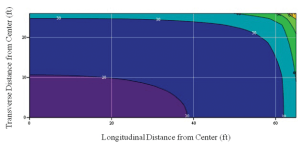
Figure 4. Distribution of subgrade modulus (kcf). B = 52 ft, L = 130 ft, tf = 3 ft, Ef = 3600 ksi, Es = 600 ksf, νs = 0.35, Hs = 60 ft, D = 3 ft.
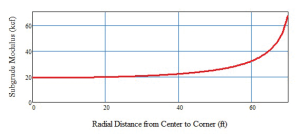
Figure 5. Subgrade modulus along diagonal line from center to corner. B = 52 ft, L = 130 ft, tf = 3 ft, Ef = 3600 ksi, Es = 600 ksf, νs = 0.35, Hs = 60 ft, D = 3 ft.
To illustrate the concept presented in Figures 3a and 3b (page 11), a 1-foot strip along the transverse centerline of the mat is modeled using the program STAAD.Pro. It is assumed that the mat supports a two-story, two-bay frame structure. Each story is 15 feet high, and each bay is 20 feet wide. The walls and slabs are 1-foot thick concrete structures, while the mat is assumed to be 1.5-feet thick. In addition to selfweight, a 100 psf uniform load is applied on the roof, slabs and mat. Construction staging is ignored.
For the first case, a constant subgrade modulus of 20 kcf supports the mat, while the second case uses a non-uniform subgrade modulus varying from 20 kcf to 37 kcf as shown along the transverse section of Figure 4. The frame displacements and bending moments for these two cases are shown on Figures 6a and 6b, respectively. Comparing results from these two cases indicates that, as discussed before, larger settlements are observed for the case when a constant minimum subgrade modulus is used underneath the mat foundation, but larger structural bending moments result when a non-uniform subgrade modulus is used.
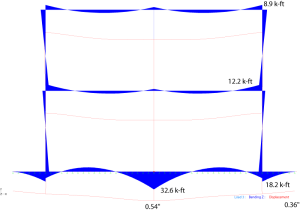
Figure 6b. Case 2 – frame displacement and bending moments; subgrade modulus varies from 20 kcf to 37 kcf.
Conclusions
- The subgrade modulus is a function of the soil stiffness and compressible layer thickness, as well as the foundation dimensions and stiffness.
- The subgrade modulus is not constant underneath a foundation.
- Using a constant, lower bound, value for the subgrade modulus underneath a foundation produces upper bound settlement but does not result in a conservative design of the structure.▪
References
Das B.M., Atalar C. and Shin E.C. 2009. Developments in Elastic Settlement Estimation Procedures for Shallow Foundations on Granular Soil. 2nd International Conference on New Developments in Soil Mechanics and Geotechnical Engineering. Nicosia, North Cyprus, 28–30 May 2009.
Dey A., Basudhar P.K. and Chandra S. 2008, Distribution of Modulus of Subgrade Reaction beneath Beams on Elastic Foundation. Proceedings of the International Geotechnical Conference: Development of Urban Areas and Geotechnical Engineering. Saint Petersburg, 16-19 June 2008.
Hetenyi M. 1946, Beams on Elastic Foundation: Theory with Applications in the Fields of Civil and Mechanical Engineering. Univ. of Michigan Press, Ann Arbor, Michigan.
Teodoru I.B. 2009, Beams on Elastic Foundation – The Simplified Continuum Approach. Buletinul Institutului Politehnic Din Iasi, Universitatea Tehnica, Gheorge Asachi, LV (LIX), Fasc. 4, 2009.
Terzaghi K.V. 1955, Evaluation of Coefficient of Subgrade Reaction. Geotechnique, Vol. 5, No. 4, pp. 297-326.

